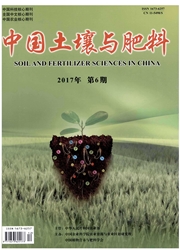

 中文摘要:
中文摘要:
通过区域调查、采样和分析,系统研究了苏北滨海围垦滩涂设施农业土壤的连作障碍特征。研究表明,随着大棚青椒和韭菜连作年限的增加,大棚土壤呈不同程度的板结趋势,0~20、20~60 cm的表、根层土壤逐渐呈轻中度的盐渍化趋势,土壤有机质、全氮、碱解氮、速效钾等养分含量呈显著降低趋势,土壤全磷、有效磷、全钾含量则无显著变化,土壤微生物数量呈显著降低趋势。滩涂青椒和韭菜连作大棚土壤基本不缺磷肥,但有补充氮肥、钾肥和有机肥的必要性。滩涂地区大棚青椒和韭菜连作3年后,土壤呈现较为严重的连作障碍特征,主要表现为严重的次生盐渍化、养分失衡和微生物环境恶化风险,全年棚期的青椒连作障碍风险尤为显著,因此提出滩涂大棚青椒和韭菜的连作年限应不超过2年。
 英文摘要:
英文摘要:
This study conducted a detailed analysis of the continuous cropping obstacle characteristics in the growing facility agriculture at the North-Jiangsn coastal reclamation region. By regional survey, sampling and analysis, the characteristics of continuous cropping obstacle in soil quality for two typical greenhouse vegetables, pepper and Chinese chive, were revealed. Results showed that with the increasing of continuous cropping years, the surface (0 -20 cm) and root-layer (20 -60 cm) soil in the two types of vegetable greenhouses turned to a hardening trend and a mild to moderate salinization trend. The soil organic matter, total nitrogen, available nitrogen and available potassium contents and the soil microbial quantities turned to the signif- icant decreasing tends, while the soil total phosphorus, available phosphorus and total potassium contents had no significant change. It was demonstrated that the soil in the continuous cropping pepper and Chinese chive greenhouses was rich in phos- phorus, but needed more nitrogen, potassium and organic fertilizers. After 3 years continuous cropping of greenhouse pepper and Chinese chive, some serious continuous cropping obstacles appeared in the greenhouse soil quality, such as the high risk of soil secondary salinization, nutrient unbalance and microbial environment deterioration. The continuous cropping obstacle in the pepper greenhouse soil was much more serious than that in the Chinese chive greenhouse soil, because of the longer time of the pepper growth covered by the plastic greenhouse. By our research it was suggested that the reasonable continuous cropping year threshold should be no more than 2 years for the pepper and Chinese chive greenhouses in the coastal reclamation region.
 同期刊论文项目
同期刊论文项目
 同项目期刊论文
同项目期刊论文
 Spatio-Temporal Changes of Soil Salinity in Arid Areas of South Xinjiang Using Electromagnetic Induc
Spatio-Temporal Changes of Soil Salinity in Arid Areas of South Xinjiang Using Electromagnetic Induc MULTIVARIATE SIMULATION AND ASSESSMENT OF THREE DIMENSIONAL SPATIAL PATTERNS OF COASTAL SOIL SALINIT
MULTIVARIATE SIMULATION AND ASSESSMENT OF THREE DIMENSIONAL SPATIAL PATTERNS OF COASTAL SOIL SALINIT Determining minimum data set for soil quality assessment of typical salt-affected farmland in the co
Determining minimum data set for soil quality assessment of typical salt-affected farmland in the co Effects of Irrigation Water Quality and Drip Tape Arrangement on Soil Salinity, Soil Moisture Distri
Effects of Irrigation Water Quality and Drip Tape Arrangement on Soil Salinity, Soil Moisture Distri Determining soil salinity and plant biomass response for a farmed coastal cropland using the electro
Determining soil salinity and plant biomass response for a farmed coastal cropland using the electro Determination of site-specific management zones using soil physico-chemical properties and crop yiel
Determination of site-specific management zones using soil physico-chemical properties and crop yiel Distribution and dynamics of soil water and salt under different drip irrigation regimes in northwes
Distribution and dynamics of soil water and salt under different drip irrigation regimes in northwes Short-term effect of cultivation and crop rotation systems on soil quality indicators in a coastal n
Short-term effect of cultivation and crop rotation systems on soil quality indicators in a coastal n Studies on soil water and salt balances and scenarios simulation using SaltMod in a coastal reclaime
Studies on soil water and salt balances and scenarios simulation using SaltMod in a coastal reclaime The Effects of Farmyard Manure and Mulch on Soil Physical Properties in a Reclaimed Coastal Tidal Fl
The Effects of Farmyard Manure and Mulch on Soil Physical Properties in a Reclaimed Coastal Tidal Fl Impact of irrigation volume and water salinity on winter wheat productivity and soil salinity distri
Impact of irrigation volume and water salinity on winter wheat productivity and soil salinity distri Fertilization Affects Biomass Production of Suaeda salsa and Soil Organic Carbon Pool in East Coasta
Fertilization Affects Biomass Production of Suaeda salsa and Soil Organic Carbon Pool in East Coasta Multiple time scale characteristics of rainfall and its impact on soil salinization in the typical e
Multiple time scale characteristics of rainfall and its impact on soil salinization in the typical e 期刊信息
期刊信息
